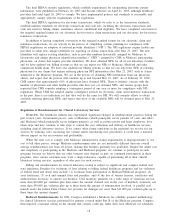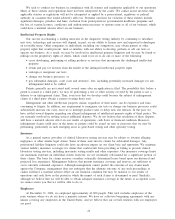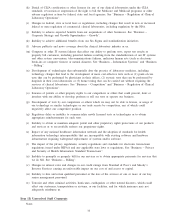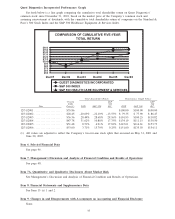Quest Diagnostics 2006 Annual Report Download - page 48
Download and view the complete annual report
Please find page 48 of the 2006 Quest Diagnostics annual report below. You can navigate through the pages in the report by either clicking on the pages listed below, or by using the keyword search tool below to find specific information within the annual report.We believe that much of our bad debt expense, which was 3.9% of our net revenues for the year ended
December 31, 2006, is primarily the result of missing or incorrect billing information on requisitions received
from healthcare providers and the failure of patients to pay the portion of the receivable that is their
responsibility, rather than credit related issues. Missing or incorrect information on requisitions adds complexity
to and slows the billing process, creates backlogs of unbilled requisitions, and generally increases the aging of
accounts receivable and bad debt expense. Failure to timely or correctly bill may lead to our not being
reimbursed for our services or an increase in the aging of our accounts receivable, which could adversely affect
our results of operations and cash flows. Failure to comply with applicable laws relating to billing federal
healthcare programs could lead to various penalties, including (1) exclusion from participation in
Medicare/Medicaid programs; (2) asset forfeitures; (3) civil and criminal fines and penalties; and (4) the loss of
various licenses, certificates and authorizations necessary to operate our business, any of which could have a
material adverse effect on our results of operations or cash flows.
Adverse results in material litigation could have an adverse financial impact and an adverse impact on our
client base and reputation.
In addition to the investigations described in “Business – Government Investigations and Related Claims”,
we are involved in various legal proceedings arising in the ordinary course of business including, among other
things, disputes as to intellectual property, professional liability and employee-related matters, as well as inquiries
from governmental agencies and Medicare or Medicaid carriers regarding billing issues. See “Business –
Regulation of Clinical Laboratory Operations” and “Intellectual Property Rights”. Some of the proceedings
against us involve claims that are substantial in amount and could result in substantial monetary damages as well
as damage to our reputation, which could have a material adverse effect on our business. We do not have
insurance or are substantially self-insured for a significant portion of any liability with respect to such claims.
See “Business – Insurance”. Although we cannot predict the outcome of such proceedings or any claims made
against us, we do not anticipate that the ultimate outcome of the various proceedings or claims will have a
material adverse effect on our financial condition, but may be material to our results of operations and cash flows
in the period in which the impact of such matters is determined or paid.
Failure in our information technology systems, including failures resulting from our systems conversions or
failures to adapt existing systems to proposed Health Information Technology (HIT) standards, could
significantly increase turnaround time, otherwise disrupt our operations, or lead to increased competition
by other providers of laboratory services, all of which could reduce our customer base and result in lost
net revenues.
Information systems are used extensively in virtually all aspects of our business, including laboratory testing,
billing, customer service, logistics and management of medical data. Our success depends, in part, on the
continued and uninterrupted performance of our information technology, or IT, systems. IT systems are vulnerable
to damage from a variety of sources, including telecommunications or network failures, malicious human acts and
natural disasters. Moreover, despite network security measures, some of our servers are potentially vulnerable to
physical or electronic break-ins, computer viruses and similar disruptive problems. Despite the precautionary
measures we have taken to prevent unanticipated problems that could affect our IT systems, sustained or repeated
system failures that interrupt our ability to process test orders, deliver test results or perform tests in a timely
manner could adversely affect our reputation and result in a loss of customers and net revenues.
We are in the process of implementing a standard laboratory information system and a standard billing
system, which we expect will take several years to complete. See “Business – Information Systems”. Failure to
properly implement this standardization process could materially adversely affect our business. During system
conversions of this type, workflow is reengineered to take advantage of best practices and enhanced system
capabilities, which may cause temporary disruptions in service. In addition, the implementation process, including
the transfer of databases and master files to new data centers, presents significant conversion risks that need to be
managed carefully.
In addition, public and private initiatives to create HIT standards and to mandate standardized clinical coding
systems for the electronic exchange of clinical information, including laboratory results, could require costly
modifications to our existing IT systems. See “Business – Healthcare Information Technology.” While we do not
expect HIT standards to be adopted or implemented without adequate time to comply, failure or delay in
implementing HIT or clinical coding standards, interoperability standards, or in adopting and incorporating
standardized clinical coding systems in our IT systems, could result in a loss of customers, a loss of business
opportunities, and could adversely affect our reputation.
27
























